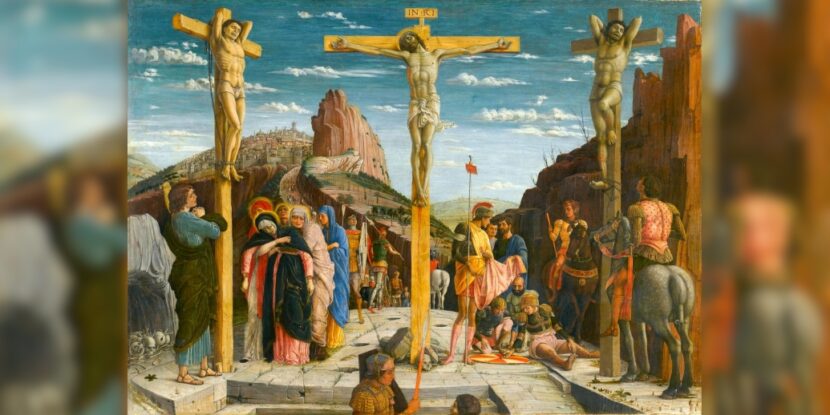Things unraveled quickly following Judas’s betrayal of Jesus. He was dragged before Caiaphas, the high priest, and subjected to a hasty trial. He remained silent until Caiaphas demanded, “I put You under oath by the living God: Tell us if You are the Christ, the Son of God!”
“It is as you said,” Jesus replied at last. “Nevertheless, I say to you, hereafter you will see the Son of Man sitting at the right hand of the Power, and coming on the clouds of heaven.”
Furious, Caiaphas tore his clothes, declaring, “He has spoken blasphemy! What further need do we have of witnesses? Look, now you have heard His blasphemy! What do you think?”
“He is deserving of death,” the other priests replied.
The Gospels tell us they beat Jesus then and spat in His face, and the guards blindfolded and mocked him: “Prophesy unto us, thou Christ, Who is he that smote Thee?”
PILATE AND HEROD.
Caiaphas did not feel he could put Jesus to death himself, however, turning to the Roman governor, Pontius Pilate, to carry out the sentence.
Pilate was reluctant. The priests told him Jesus was a rebel, declaring Himself king, but Jesus answered that His kingdom was not of this world.
Learning Jesus was from Galilee, Pilate sent Him to Herod, the Romans’ client king and the son of Herod the Great — responsible for the Massacre of the Innocents when Jesus was born — in hopes he would resolve the matter in his stead.
Herod, though he had been greatly excited to meet the preacher so much under discussion, found He was silent, but was more amused than angry. He mocked Jesus, dressed Him in a fine robe, and sent Him back to Pilate.
Again, the priests demanded Jesus’s death. Pilate sought to assuage them by having Jesus terribly beaten, with the cruel Roman soldiers pressing a crown of thorns upon His head in mockery of His kingship — but seeing Jesus in this terrible state was not enough for the priests either.
Finally, Pilate sought to escape his predicament by offering to pardon one prisoner, either Jesus or the criminal Barrabas, a robber, murderer, and insurrectionist.
The priests incited crowds assembled for the pardoning ceremony to call for Barrabas’s release.
“I am innocent of the blood of this just Person,” Pilate claimed, taking water and symbolically washing his hands of the matter – though He sent Jesus to His crucifixion regardless.
THE PLACE OF THE SKULL.
Jesus was told to drag His own cross to Golgotha, known as the place of the skull, to meet His fate. His tortured, earthly body was too weak for the task, however, and a man named Simon of Cyrene had to assist Him.
The soldiers nailed Him to a cross, bearing a sign Pilate had written for him in Latin, Greek, and Hebrew, identifying Him, to the priests’ dismay, as ‘Jesus of Nazareth, King of the Jews.’
His mother, Mary, was there, as well as his mother’s sister, as well as Mary Magdalene, and His disciple St. John. He entrusted His mother to the disciple’s care, and He prayed for His executioners.
“He saved others; Himself He cannot save,” the priests mocked. “If He is the King of Israel, let Him now come down from the cross, and we will believe Him. He trusted in God; let Him deliver Him now if He will have Him; for He said, ‘I am the Son of God.’”
“Father, forgive them; for they know not what they do,” Jesus prayed.
Later, He cried, “My God, My God, why hast Thou forsaken Me?”
“This Man is calling for Elijah!” some of the crowd shouted. “Let Him alone; let us see if Elijah will come to save Him.”
But they misunderstood, for Jesus was not speaking for Himself, but quoting the beginning of Psalm 22, where King David speaks of being forsaken, of having his hands and his feet pierced, like Himself on the cross, and of his undying faith.
IT IS FINISHED.
Then Jesus declared, “It is finished.”
Scripture, and His mission to die for mankind’s sins, had been fulfilled. He commended His spirit into the hands of the Father — and “gave up the ghost.”
“Then, behold, the veil of the temple was torn in two from top to bottom; and the earth quaked, and the rocks were split,” St. Matthew tells us in his Gospel, describing the wrathful scene as the death sentence of the Son of Man was completed.
Even the Roman centurion and soldiers guarding Him “feared greatly” at the scene, saying, “Truly this was the Son of God!”
Perhaps it was this fear that persuaded Pilate to let St. Joseph of Arimathea take down Jesus’s body and bury Him when the condemned were not customarily allowed such privileges. This he did, wrapping his master’s body in linen and sealing the tomb with a great rock.
But He would not remain there.
"Destroy this temple, and in three days I will raise it up."#GoodFriday pic.twitter.com/do7R1MGL3z
— Jack Montgomery (@JackBMontgomery) March 29, 2024


